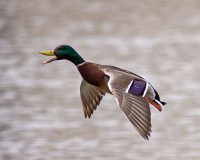You’re about to learn some of the most interesting mallard duck facts. Mallard duck (Anas platyrhynchos) is a bird that breeds in the subtropical habitats of Africa and America. Mallard is highly adaptable bird and it is not scared of humans. The bird is also found in urban areas. Mallard is a medium sized bird and it is the most familiar of all ducks. It is a dabbling duck.
Mallard Duck Facts for Kids
The male mallard is recognized by its glossy green head. Mallards have bill measuring at 4.1 – 6.6 cm.
The overall length of the mallard is about 60 – 85 cm with the wingspan measuring at 81 – 98 cm. Adult mallard weighs 1.6–3.5 pounds. The wing chord is about 25.7 to 30.6 cm.
Mallards produce quite many vocalizations such as a typical quack or a breeeeze.
They live in southern and central Alaska as well as Eurasia, southern Greenland, Scandinavia, Hawaiian Islands, North Africa (Morocco), Iceland, Britain, japan, North Korea, Central America, and northern Mexico.
 Mallard Duck Habitat: The mallard duck makes home in a wide variety of habitats such as parks, estuaries, shallow inlets, lakes, small ponds, rivers, freshwater and saltwater wetlands.
Mallard Duck Habitat: The mallard duck makes home in a wide variety of habitats such as parks, estuaries, shallow inlets, lakes, small ponds, rivers, freshwater and saltwater wetlands.
Mallard Duck Diet: Mallards are omnivores. They will consume numerous invertebrates including flies, caddisflies, beetles, lepidopterans, worms, and crustaceans. Mallards also feed on plants and seed matter. Most of the mallard’s diet consists of plants.
The breeding season occurs in October and November in which the female lays 8 – 13 eggs. The eggs are greenish-bluff in color with no spots whatsoever.
The incubation period ranges from 27 – 28 days and fledging takes almost 2 months.
Adult males are more likely to be aggressive as compared to adult females.
Mallards fly at a speed of 55 miles per hour. They are migratory species.
Mallard Duck Predators: Mallards have many predators in the wild. Predators include skunks, raptors, corvids, turtles, felids, mustelids, raccoons, snakes, canids, peregrine falcons, short-eared owls, northern pike, European herring gull, large fish, and mute swan.
Mallard Duck Lifespan: Mallards have an average lifespan of about 3 years but they can live as long as 20 years.
You might be interested in





